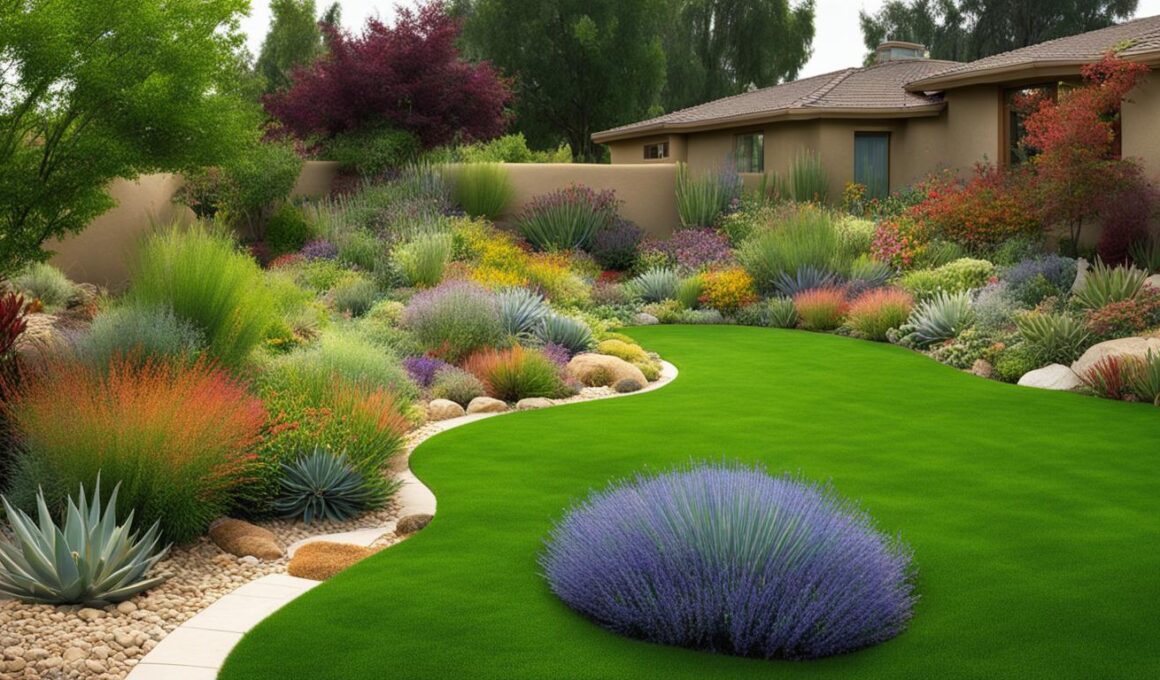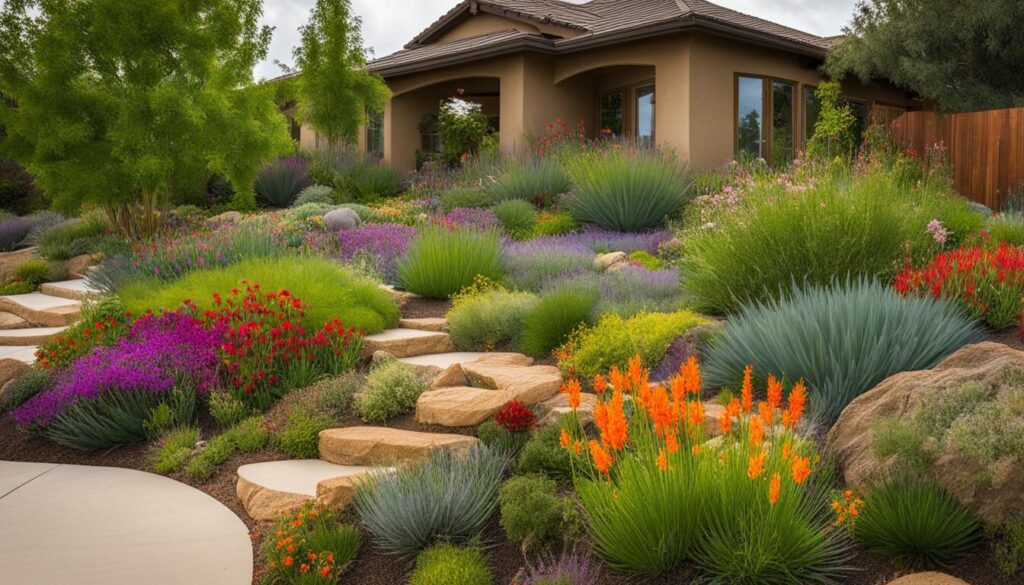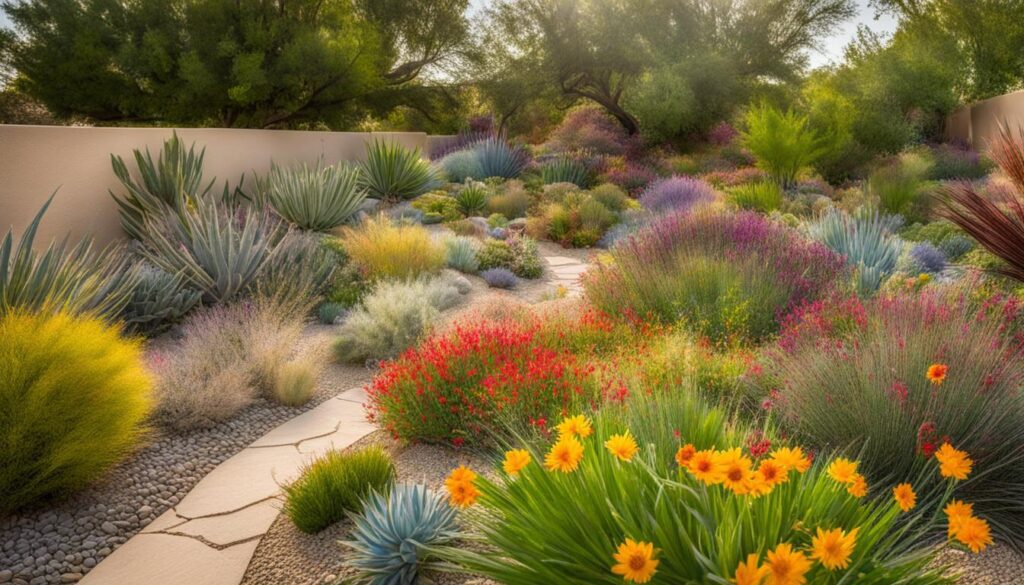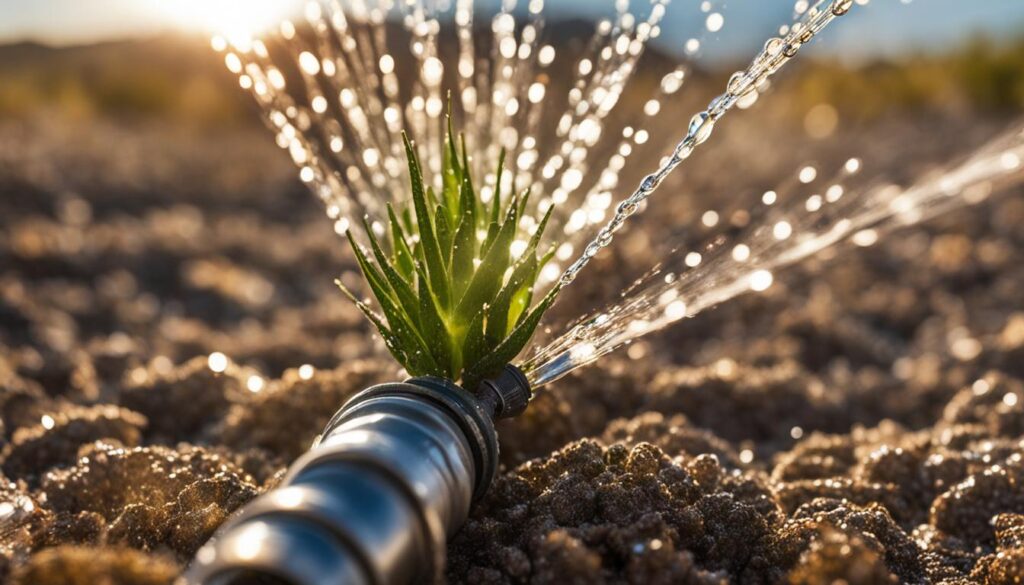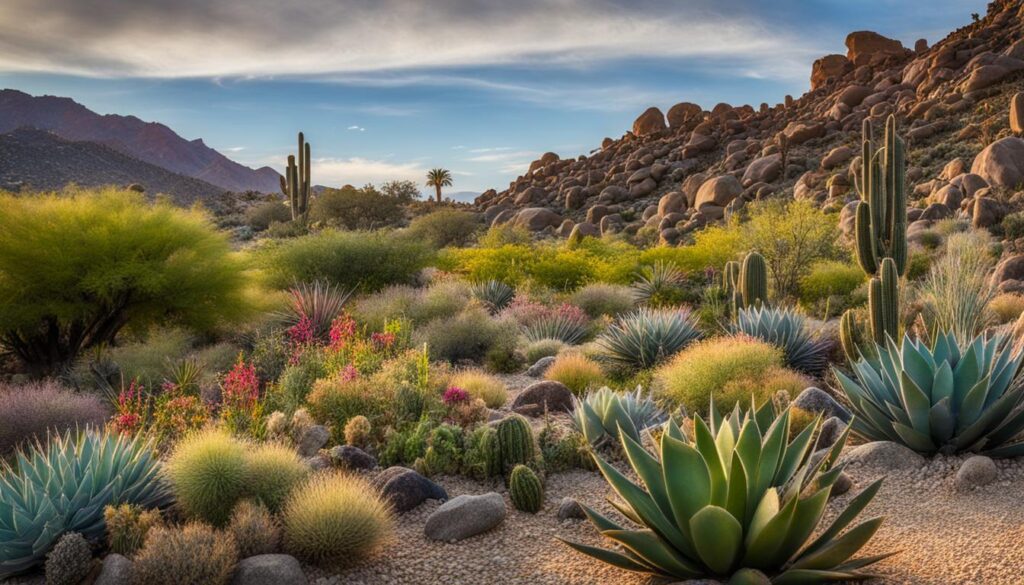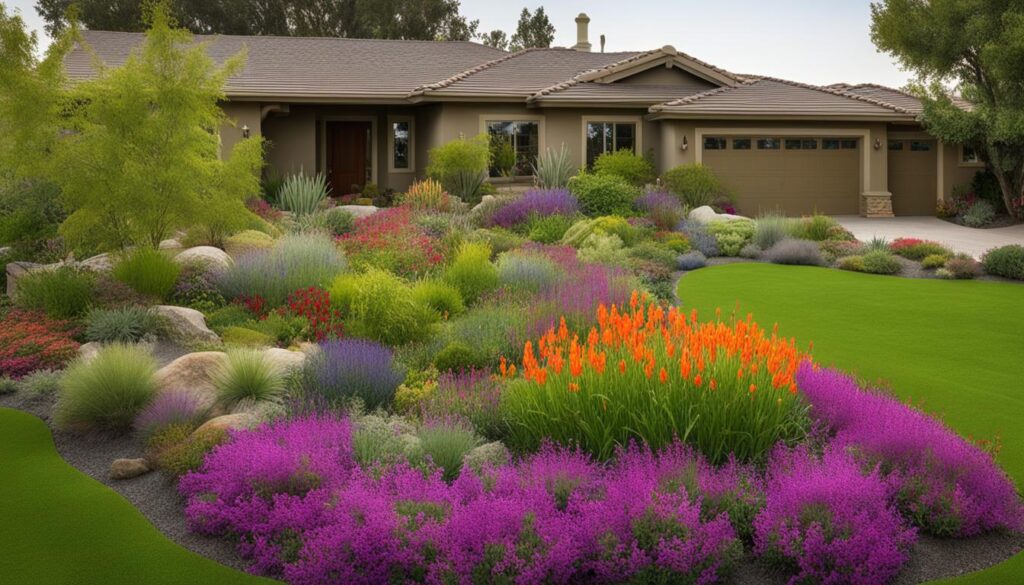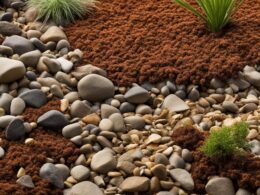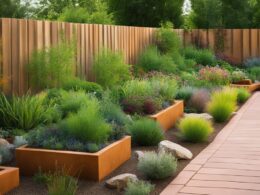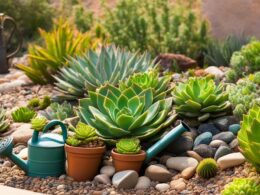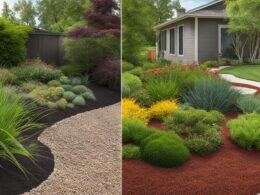Are you looking to transform your lawn into a sustainable and environmentally friendly landscape? Consider embracing xeriscape conversion with native species. Xeriscaping is a landscaping technique that aims to reduce or eliminate the need for irrigation by designing landscapes that use the natural climate to provide water. By replacing grassy lawns with soil, rocks, mulch, and drought-tolerant native plant species, xeriscape conversion not only saves water but also has environmental and financial benefits.
Key Takeaways:
- Xeriscape conversion involves replacing grassy lawns with drought-tolerant native plant species.
- It offers environmental benefits such as water savings and conservation of natural habitats.
- Xeriscape conversion can save homeowners money on water bills and maintenance costs.
- Drip irrigation and grouping plants with similar water needs are efficient methods for xeriscape conversion.
- Xeriscaping is a sustainable and visually appealing choice for landscaping.
The Environmental and Financial Benefits of Xeriscape Conversion
Xeriscape conversion offers several environmental benefits. By choosing drought-tolerant vegetation and native species, xeriscaping reduces water use by 50 to 75 percent, resulting in significant water savings. Additionally, xeriscaping helps conserve water and promotes the preservation of natural habitats. From a financial perspective, xeriscaping can save homeowners money by reducing water bills and maintenance costs.
“Xeriscaping can save homeowners money by reducing water bills and maintenance costs.”
For example, in Novato, California, houses that chose xeriscaping saved an estimated 120 gallons of water per day. With its potential for water conservation and cost savings, xeriscape conversion is an attractive option for sustainable landscaping.
Environmental Benefits
The environmental benefits of xeriscape conversion are substantial. By reducing water consumption, xeriscaping helps address water scarcity issues, particularly in arid regions. The use of drought-tolerant plants and native species promotes water conservation by minimizing irrigation needs. This not only saves a valuable natural resource but also reduces the strain on water supply systems.
Financial Benefits
Financially, xeriscape conversion can lead to long-term cost savings for homeowners. The reduced need for watering and maintenance translates to lower water bills and decreased expenses for lawn care. Xeriscaping eliminates the need for chemical fertilizers and pesticides, further reducing costs and potential harm to the environment.
| Xeriscape Conversion | Traditional Grass Lawns | |
|---|---|---|
| Water Consumption | 50-75% reduction | High water demand |
| Maintenance Costs | Low maintenance | Regular mowing, fertilizers, pesticides |
| Water Bill Savings | Significant | Higher water bills |
As shown in the table above, xeriscape conversion offers clear advantages over traditional grass lawns in terms of water consumption, maintenance costs, and water bill savings.
Xeriscape Conversion and Drought-Tolerant Plants
Xeriscape conversion often involves replacing grassy lawns with drought-tolerant plants that are well-adapted to arid climates. By choosing these plants, you can create an attractive and sustainable landscape that thrives with minimal water usage. Drought-tolerant plants have unique characteristics that allow them to survive in dry conditions, making them ideal for xeriscaping projects.
Drought-Tolerant Plant Examples:
- Cacti: Known for their ability to store water, various species of cacti are excellent choices for xeriscape conversion. With their interesting shapes and textures, cacti can add visual interest to your landscape while requiring little to no irrigation.
- Agave: This succulent plant is native to arid regions and can tolerate prolonged periods of drought. Agave comes in a variety of shapes and sizes, making it a versatile option for xeriscaping projects.
- Juniper: With its evergreen foliage, juniper is a popular choice for xeriscape gardens. It requires minimal water and can thrive in various soil types.
- Lavender, Thyme, Sage, and Oregano: These aromatic herbs not only add beauty to your landscape but also attract pollinators. They are well-suited for xeriscaping due to their ability to tolerate dry conditions.
When selecting drought-tolerant plants for your xeriscape conversion, consider their water needs, growth habits, and compatibility with your local climate. By choosing the right plants, you can create a vibrant and sustainable landscape that requires less water and maintenance compared to traditional grass lawns.
Table: Comparison of Drought-Tolerant Plants
| Plant | Water Needs | Benefits |
|---|---|---|
| Cacti | Low | – Water storage capabilities – Unique shapes and textures |
| Agave | Low | – Drought tolerance – Versatile shapes and sizes |
| Juniper | Low | – Evergreen foliage – Adaptable to various soil types |
| Lavender, Thyme, Sage, and Oregano | Low to medium | – Aromatic fragrance – Attracts pollinators |
“Xeriscape conversion allows you to create a beautiful and sustainable landscape by choosing drought-tolerant plants that thrive in dry conditions.”
By incorporating drought-tolerant plants into your xeriscape conversion, you can create a landscape that not only conserves water but also adds beauty and value to your property. Take advantage of the wide variety of plants available and create a xeriscape design that suits your personal preferences and local climate. With proper planning and plant selection, your xeriscape garden will flourish, even in arid regions.
Efficient Irrigation Methods for Xeriscape Conversion
When it comes to xeriscape conversion, implementing efficient irrigation methods is crucial for maximizing water conservation and minimizing maintenance. By selecting the right irrigation system and techniques, you can ensure that water is distributed effectively and efficiently to your xeriscaped landscape.
The two commonly used irrigation methods for xeriscape conversion are drip irrigation and soaker hoses. Drip irrigation involves delivering water directly to the base of plants through a series of tubes or emitters. This method minimizes water evaporation and ensures that water is targeted precisely where it is needed, reducing waste. Soaker hoses, on the other hand, are porous hoses that slowly release water along their entire length. They are placed near the plants, allowing water to seep directly into the soil and reach the roots.
To further optimize irrigation efficiency, it is essential to group plants with similar water needs together. By grouping plants with similar water requirements, you can avoid overwatering or underwatering certain areas of your landscape. By providing the appropriate amount of water to each plant, you can create a more sustainable and thriving xeriscape.
Ultimately, by implementing efficient irrigation methods, you can ensure that your xeriscape conversion project is successful in conserving water, reducing maintenance efforts, and promoting the health and vitality of your landscape.
Table: Comparison of Drip Irrigation and Soaker Hoses
| Irrigation Method | Advantages | Disadvantages |
|---|---|---|
| Drip Irrigation |
|
|
| Soaker Hoses |
|
|
The Origins of Grass Lawns and Their Drawbacks
Grass lawns, often associated with the American dream, have a long history that dates back to European settlers in the 1600s. However, these lush green expanses come with their drawbacks. Traditional grass lawns, especially species like Kentucky bluegrass, are notoriously water-intensive and require significant maintenance. The shallow root systems of many popular grasses necessitate frequent watering, contributing to high water consumption.
Furthermore, the use of nitrogen fertilizers and gas-powered mowers for lawn maintenance can have detrimental effects on the environment. Nitrogen runoff from fertilizers can lead to water pollution in nearby streams, rivers, and lakes, while the emissions from gas-powered mowers contribute to air pollution. The maintenance of grass lawns also limits the availability of natural habitats, reducing biodiversity and impacting local ecosystems.
“Traditional grass lawns, especially species like Kentucky bluegrass, are notoriously water-intensive and require significant maintenance.”
Considering the drawbacks of grass lawns, it’s no wonder that homeowners are seeking alternatives that are more sustainable and environmentally friendly. This shift in landscaping preferences has led to the rise of xeriscaping and native landscaping.
Image source: https://seowriting.ai/32_6.png
The Appeal of Xeriscaping and Native Landscaping
Xeriscaping has gained appeal as an alternative to traditional grass lawns due to its water conservation and environmental benefits. Homeowners, especially in drought-prone regions, are increasingly adopting xeriscaping to save money on water bills and reduce maintenance efforts. Native landscaping, which involves using indigenous plants that are well-adapted to local climates, offers both beauty and ecological advantages. Native landscapes can support local wildlife populations and provide a sense of connection with the surrounding environment. With educational programs promoting sustainable landscaping and the availability of resources for xeriscaping, this landscaping approach is becoming more mainstream.
Benefits of Xeriscaping and Native Landscaping
Xeriscaping offers numerous benefits beyond water conservation. By replacing traditional lawns with native plants, xeriscaping reduces the need for water-intensive irrigation and minimizes the use of fertilizers and pesticides. This environmentally friendly approach promotes healthier ecosystems by preserving natural habitats and supporting local biodiversity. Additionally, xeriscaping reduces maintenance requirements, saving homeowners time and effort. The appeal of xeriscaping lies in its ability to create visually stunning landscapes that are both sustainable and ecologically beneficial.
“Xeriscaping is not only environmentally beneficial but also provides an opportunity to create beautiful and diverse landscapes.”
Native Species in Xeriscaping
Native species play a crucial role in xeriscaping projects. These plants have evolved to thrive in the local climate and require less water, making them well-suited for xeriscape gardens. Incorporating native species in landscaping helps preserve regional identity and supports the local ecosystem. Additionally, native plants often feature vibrant colors, unique textures, and interesting shapes, adding aesthetic appeal to xeriscape designs. By selecting native species for their xeriscape conversions, homeowners can create visually captivating landscapes that harmonize with the natural surroundings.
The Future of Xeriscaping
As awareness of water scarcity and environmental conservation grows, xeriscaping and native landscaping are poised to become even more popular in the future. Educational programs and resources are readily available to help homeowners embrace this environmentally sustainable landscaping approach. With its ability to conserve water, minimize maintenance, and enhance the beauty of outdoor spaces, xeriscaping offers an appealing and practical solution for sustainable landscaping.
Xeriscape Conversion: A Sustainable Choice for Landscaping
When it comes to creating a sustainable and environmentally friendly landscape, xeriscape conversion is an excellent option to consider. By replacing traditional grass lawns with drought-tolerant plants and incorporating efficient irrigation methods, you can significantly reduce water consumption, lower maintenance requirements, and support local ecosystems.
One of the key benefits of xeriscape conversion is its ability to conserve water. By choosing drought-tolerant plants that are well-adapted to the local climate, you can reduce water consumption by 50 to 75 percent compared to traditional lawns. This is especially important in regions facing water scarcity, where every drop counts. Additionally, xeriscaping helps preserve natural habitats and promotes biodiversity by using native species that support local wildlife populations.
In addition to its environmental advantages, xeriscape conversion also offers financial benefits. By reducing water usage, homeowners can save money on their water bills. Xeriscaped landscapes require minimal maintenance, eliminating the need for fertilizers and pesticides commonly used on grass lawns. This not only reduces ongoing costs but also helps protect the environment from harmful chemicals. Furthermore, xeriscape conversion can increase property values and protect your landscaping investment.
In conclusion, xeriscape conversion is a sustainable and aesthetically pleasing choice for landscaping. By embracing this approach, you can contribute to water conservation efforts, support local ecosystems, and enjoy the financial benefits of lower water bills and reduced maintenance costs. With its versatility and ability to adapt to various geographic regions, xeriscape conversion is a practical solution for creating a beautiful and eco-friendly lawn.
Table: Benefits of Xeriscape Conversion
| Benefits | Description |
|---|---|
| Water Conservation | Reduces water usage by 50 to 75 percent compared to grass lawns. |
| Environmental Preservation | Supports local ecosystems and promotes biodiversity with native plant species. |
| Financial Savings | Reduces water bills and maintenance costs for homeowners. |
| Increased Property Value | Enhances the value of the property and protects landscaping investments. |
What Native Species Can I Use for Xeriscaping Conversion?
When considering which native species to use to convert your lawn to xeriscape, look for plants like lavender, yarrow, and sage. These drought-tolerant options can thrive in low water conditions and create a beautiful, sustainable landscape for your home.
Conclusion
Xeriscape conversion with native species provides a practical and sustainable solution for revamping your lawn. By embracing xeriscape principles and choosing drought-tolerant plants, you can reduce water consumption, save money, and support local ecology.
Not only is xeriscaping environmentally beneficial, but it also offers an opportunity to create beautiful and diverse landscapes. With its potential to conserve water, reduce maintenance, and enhance the value of your property, xeriscape conversion is a compelling choice for those seeking an eco-friendly and visually appealing lawn.
So, why wait? Start your xeriscape conversion today and transform your lawn into a vibrant and sustainable oasis using native species that are well-suited to your region’s climate and water conditions.





